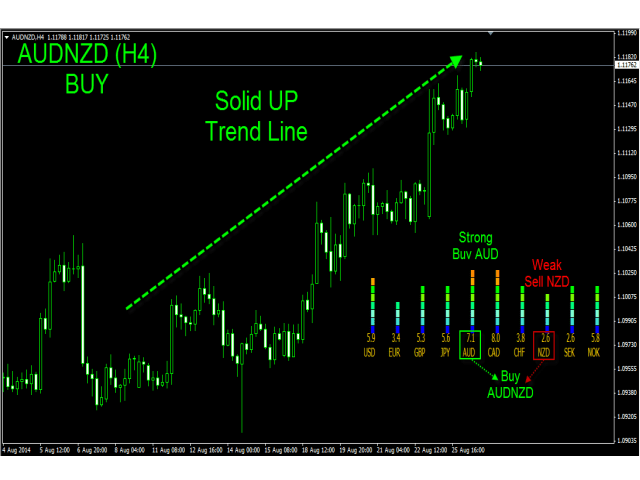The indicator determines the strength of each base currency by assigning it a value from 0 to 10. The strength of a currency is calculated by comparing it with 9 quoted currencies. Thus, you get a complete picture of the current behavior of the currency in the whole market.
Search for strong and weak currencies
(see the screenshot)
The indicator assigns a value from 0 to 10 to ten base currencies, showing the strength of each of them.
- The closer the value is to 10, the stronger the currency is and the more likely its price will rise.
- The closer the value is to 0, the weaker the currency is and the more likely it is that its price will fall.
The value is calculated based on a comparison of the base currency with several quoted currencies. Thus, we get general information about the strength of a given base currency in the whole market (and not just relative to any one currency).
Search for strong trend pairs to trade
It is necessary to buy a currency with a high value (above 6.5), selling it relative to a currency with a low value (below 4.5).
Example 1: CAD has a value of 8.0, while EUR is 3.4. So, we sell EUR and buy CAD. Therefore, we sell EURCAD. In the screenshot below, you can see that EURCAD is falling.
[spoiler title=”Read More…”]
Example 2: AUD has a value of 7.1, NZD-2.6. So, we buy AUD and sell NZD. Therefore, we buy AUDNZD. In the screenshot below, you can see that AUDNZD is growing.
For each currency in the Specific Currency Crosses, a strength value from 0 to 10 is calculated. The value is calculated using 10 trend indicators. Each indicator adds 1 or -1 to the value, depending on the trend direction that the indicator points to. After calculating all currency crosses, a weighted average is calculated for each currency to output the final value.
Currencies. The specified parameters refer to the currencies used in creating the table.
- Currency# – select the base currency to use in the position #. You must specify the currency, not the currency pair.
- terminalsuffix – if your broker uses a suffix in the symbol name, enter it here.
- terminalprefix – if your broker uses a prefix in the symbol name, enter it here.
- useweights – if true, each currency will have its own individual weight when calculating the strength of each currency. If false, a single weight is set for all currencies.
- weightsCurrency# – determine the weight of each currency when calculating the strength of the currency #. You must enter 10 comma-separated numbers. The number n corresponds to the weight of the currency n. (Example: Currency# – USD. A series of numbers – “1,2,3,4,5,6,7,8,9,10”. Currency pair #1 will have a weight of 1, currency pair #2 will have a weight of 2, currency pair #3 – 3, currency pair #4 – 4, currency pair #10-10).
- shift(0) – the number of periods (candles) processed during the analysis. You can change this value to see how the strength of the currencies changes over time.
- MaLongMethod(0) – averaging enumeration method for a long moving average. The parameter can take the following values (0 – simple, 1-exponential, 2-smoothed, 3-linear-smoothed).
- MaLongLength(55) – the averaging period for calculating the long moving average.
- MaShrtMethod(0) – averaging enumeration method for the short moving average. The parameter can take the following values (0 – simple, 1-exponential, 2-smoothed, 3-linear-smoothed).
- MaShrtLength(20) – the averaging period for calculating the short moving average.
- RSIlength(14) – the averaging period for calculating the RSI indicator.
- RSIlevel (50) – the threshold level above/below which the trend is defined as ascending/descending when using the RSI indicator.
- MACDFastEMA(12) – fast EMA averaging period for calculating the MACD indicator.
- MACDSlowEMA(26) – the period of averaging the slow EMA for calculating the MACD indicator.
- MACDSMA(9) – the signal line averaging period for calculating the MACD indicator.
- SARstep(0.02) – stop step for the Parabolic SAR indicator.
- SARmax(0.2) – stop step for the Parabolic SAR indicator.
- MOMlength(22) – the maximum value of the stop level for calculating the Momentum indicator.
- MOMtrendLevel (100) – the threshold level above/below which the trend is defined as ascending/descending when using the Momentum indicator.
- ADXperiod(14) – the averaging period for calculating the Average Directional Movement Index indicator.
- textColor – the color of the text.
- TextSize – the size of the text.
- corner – a value from 0 to 4 for determining the corner position of the table.
- xstart–the horizontal coordinate for the initial position of the table.
- xgap – horizontal gap between the divisions in the table.
- ystart–the vertical coordinate for the initial position of the table.
- ygap – vertical gap between the divisions in the table
- emptybarcol – color of the empty sections of bars (part of the bars that is not filled). If you don’t want it to be displayed, set it to the same color as the chart background.
- lvcol# – color of the section of the bar that has the strength value #.
[/spoiler]





